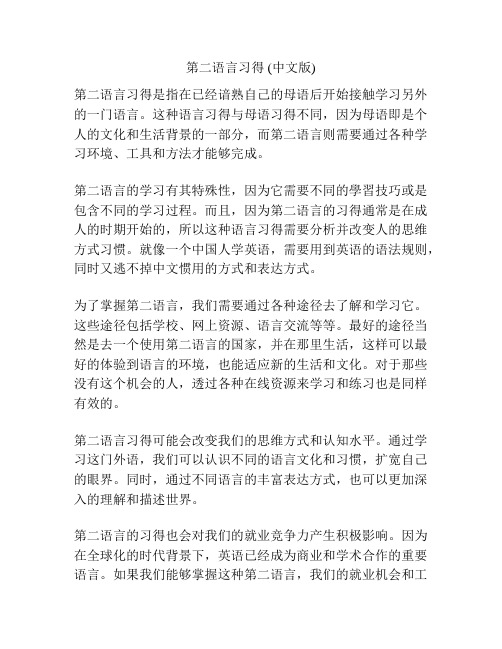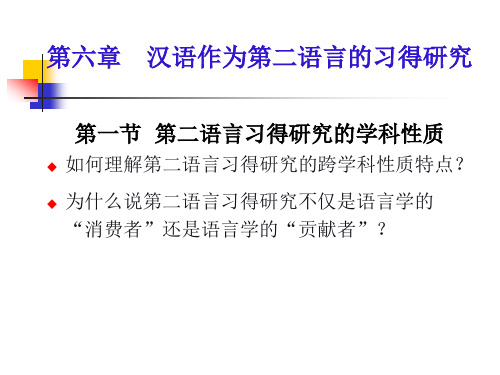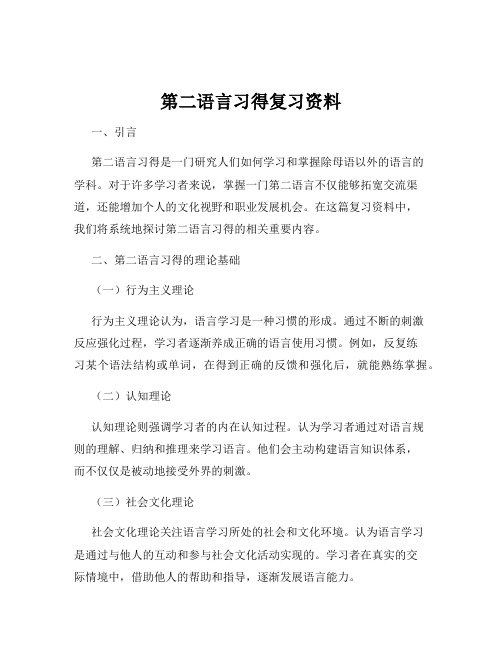第二语言习得
《第二语言习得研究》重点知识点

《第二语言习得研究》重点知识点一、第二语言习得理论1.第二语言习得与第一语言习得的区别:第二语言习得是指学习者在已经掌握第一语言的基础上学习第二语言,与第一语言习得有所不同。
2.共同的习得条件:第二语言习得与第一语言习得都受到认知、社会、情感等多种因素的影响。
3.输入假设:学习者习得第二语言的过程中需要大量的输入来构建语言知识和语言能力。
二、第二语言习得过程1.初始期:学习者对第二语言的习得处于初始阶段,主要表现为对语言规则的不熟悉,需要借助外语教学材料和教师的指导。
2.中期:学习者开始积累语言知识,并能够进行简单的口语表达和书面表达,但仍然存在语法错误和用词不准确等问题。
3.发展期:学习者的语言技能和语言运用能力在这个阶段得到显著提高,能够流利地进行口语交流和书面表达。
4.准母语期:学习者的第二语言已经达到与母语相近的程度,几乎能够毫无困难地实现听、说、读、写等各方面的能力。
三、第二语言习得影响因素1.基础能力:个体的智力、工作记忆、认知能力等对第二语言习得有重要影响。
2.学习策略:学习者在习得第二语言过程中采取的方法和策略也对习得效果产生影响。
3.情感因素:学习者对学习第二语言的情感态度、自信心等情感因素对习得过程产生影响。
4.环境因素:学习者所处的学习环境,包括学校、家庭、社会环境等对第二语言习得有影响。
四、第二语言习得教学策略1.输出与输入平衡:教师应当提供足够的输入,同时鼓励学习者进行口语和书面的输出。
2.合作学习:通过合作学习,学习者能够在与他人进行互动中提高第二语言的流利度和准确度。
3.语境创设:教师可以通过创设各种真实的语言交际情境来提高学习者的第二语言习得效果。
4.个性化教学:教师应根据学习者的个体差异,采取不同的教学策略和方法,满足每个学习者的学习需求。
以上是《第二语言习得研究》的重点知识点。
了解这些知识点能够帮助我们更好地理解学习者在学习第二语言过程中的习得情况,并且在实际的第二语言教学中有所借鉴。
第二语言习得

第二语言习得理论第二语言习得基本概念1.习得与学习:语言习得是一种下意识的过程,类似于儿童习得母语的方式;学习是有意识地学习语言知识,能够明确地意识到所学的规则。
区别:A.目的性:习得是一种潜意识的行为,目的性不明确;学习则是主体为了掌握一种新的交际工具所进行的目的性非常明确的活动,是一种有意识的行为。
B.环境:习得一般是在使用该目的语的社会环境中进行的;学习主要在课堂环境下进行,可能有目的语环境,也可能没有。
C.注意点:习得时注意力主要集中在语言的功能和意义上;学习的主要注意点在语言形式上,有意识的系统的掌握语音、词汇、语法,却经常忽视了语言的意义。
D.学习途径:习得的方法主要靠自然语言环境中的语言交际活动,没有教材和大纲;学习是在教师指导下通过模仿和练习来掌握语言规则。
E.时间:习得需要大量的时间,习得效果一般很好;学习花费时间一般很少,但学习效果通常不佳。
F.有无意识:习得是潜意识的自然的获得;学习是有意识的规则的掌握。
2、外语习得与第二语言习得:外语习得是指学习者在非目的语国家学习目的语。
第二语言习得是指学习者在目的语国家学习目的语。
学习者所学的目的语在目的语国家是公认的交际工具,也是学习者用来交际的工具。
3、语言习得机制:它脱离人类的其他功能而独立存在,与智力无关。
语言习得机制包括两部分:一部分是以待定的参数形式出现的、人类语言所普遍具有的语言原则,又称为“普遍语法”。
第二部分是评价语言信息的能力,也就是对所接触到的实际语言的核心部分进行语言参数的定值。
4、中介语:1969年由美国语言学家塞林克提出的,是指在第二语言习得中形成的一种既不同于母语也有别于目的语、随着学习的进展不断向目的语过渡的动态语言系统。
中介语理论有利于探索学习者语言系统的本质,发现第二语言习得的发展阶段,揭示第二语言的习得过程及第一语言的影响。
5、普遍语法:语言习得机制包括两个方面:一部分以待定的参形式出现的、人类语言所普遍具有的语言原则。
第二语言习得的心理学

• 第二语言习得可以分为母语式和 非母语式 • 母语式:在母语环境中学习第二 语言,如儿童学习英语 • 非母语式:在非母语环境中学习 第二语言,如成人学习英语
• 自然习得:在日常生活中自然而 然地学习第二语言,如与母语使用 者的交流 • 正式学习:在课堂或培训环境中 系统地学习第二语言,如学校课程 或语言培训课程
• 强调学习者内在因素在第二语言 习得中的作用 • 代表理论有:皮亚杰的认知发展 理论、布鲁纳的结构主义理论等
社会文化理论:认为第 二语言习得是与社会环 境、文化背景密切相关
的
• 强调社会互动和文化适应在第二 语言习得中的作用 • 代表理论有:维果茨基的社会文 化理论、哈贝马斯的交往行为理论 等
第二语言习得的阶段性特点
02
母语与第二语言习得的关系
• 母语知识丰富的学习者,在第二语言习 得过程中更容易掌握语言结构和词汇 • 母语与第二语言相似程度高的学习者, 在第二语言习得过程中更容易掌握语言规 律
教学方法与第二语言习得效果
教学方法与第二语言习得效果的关系
• 有效的教学方法能提高学习者的第二语言习得效果,提高语言技能和语言知识水平 • 适当调整教学方法,满足不同学习者的需求,有助于提高第二语言习得效果
• 第二语言习得是一个认知过程,涉及 到学习者的知觉、记忆、思维等认知能 力 • 认知心理学为第二语言习得提供了理 论支持和研究方法
认知心理学与第二语言习得的研究主要 集中在认知方式、认知策略等方面
• 认知方式:如场依存性、场独立性等, 影响学习者在第二语言习得过程中的信 息加工方式 • 认知策略:如归纳法、演绎法等,影 响学习者在第二语言习得过程中的信息 处理和解决问题的能力
02
干预研究的方法
第二语言习得研究

第二语言习得研究第一章第二语言习得研究概述第二语言习得研究作为一个独立的研究领域至今已有40年的历史。
成熟的标志:1.第二语言习得研究的领域不断扩大2.第二语言习得研究涉及的领域越来越宽3.第二语言习得研究从最初的理论假设发展成为一系列的理论模式。
总之, 已经成为一门相对独立的学科。
第一节第二语言习得研究的基本概念一、母语和目的语母语: 通常指学习者所属种族、社团使用的语言, 因而也称作“本族语”。
也称作“第一语言”。
目的语: 也称目的语, 一般指学习者正在学习的语言。
对于第二语言学习者而言, 母语对其目的语的习得具有重要的影响。
二、第一语言和第二语言第一语言: 指儿童由您最先接触和习得的第一语言。
第二语言: 是相对于学习者习得的第一语言之外的任何一种其他语言而言的。
第二语言的概念强调的是语言习得的先后顺序, 与语言习得的环境无关。
三、习得与学习这一对概念用来区分, 两种不同的语言获得的过程和方式。
习得: 类似于儿童母语的获得方式。
学习:指“正式”的语言规则学习, 及通过课堂教学的方式来获得第二语言。
四、第二语言习得与外语习得依据学习者语言习得环境来区分。
第二语言习得是指学习者在目的语国家学习目的语。
学习者所学目的语在该国家是工人的交际工具。
外语习得, 在课堂之外不作为交际工具。
五、自然的第二语言习得与有指导的第二语言习得语言获得方式和环境。
自然的第二语言习得是指以交际的方式获得第二语言。
有指导的第二语言习得是以教学指导的方式获得第二语言, 语言习得通常是在课堂教学环境中发生的。
六、语言能力与语言表达语言能力是由交际双方内在语法规则的心理表征构成的。
语言表达指的是交际双方在语言的理解与生成过程中对其内在语法的运用。
例: 你过来了吗?你说对的。
第二节第二语言习得研究的学科性质一、第二语言习得研究与语言学1.第二语言习得研究从诞生那天起, 就与语言学有一种天然的联系。
2.区别: 一方面, 就研究对象而言, 母语者的语言系统;学习者的语言系统另一方面, 研究目的不同,第三, 语言学家和第二语言习得研究者在分析和解释学习者语言系统的方法上也有所不同。
第二语言习得之概论

第二语言习得之概论首先,第二语言习得与第一语言习得有所不同。
第一语言习得是指婴儿从出生开始,通过听、说等方式自然而然地掌握母语的过程。
相比之下,第二语言习得是指在已掌握一种语言的基础上,学习并使用另一种语言。
学习一门新的语言需要借助外部资源,如教材、教师等。
在第二语言习得的研究领域,有许多理论来解释这个过程。
其中最著名的是克拉申提出的输入假设和通信策略假设。
输入假设认为学习者只能通过大量和适度难度的输入来习得第二语言。
而通信策略假设则关注学习者为了完成交际目标而使用的一系列策略。
另外,还有赖尔森-强度假设认为情感和情绪因素对第二语言习得起到重要作用。
第二语言习得的过程受到多个因素的影响。
首先,个体差异是一个重要的因素。
不同人对语言习得的天赋和能力各不相同。
例如,有些人天生对语音的敏感度较高,可以更容易地习得发音。
其次,语言输入的质量和数量也会对第二语言习得产生影响。
学习者需要接触到足够地有意义和丰富的语言输入。
此外,社会因素也是一个重要因素。
学习者所处的语言社群以及相关的文化因素都会对语言习得产生影响。
第二语言习得的策略也是一个重要的研究领域。
学习者使用各种策略来帮助他们习得第二语言。
例如,重组策略是指学习者将已知的语言元素重组成新的语言形式。
还有输出策略,即通过使用新学的语言来练习和巩固。
这些策略可以提高学习效果,帮助学习者更快地习得第二语言。
除了理论和策略,教学方法也是第二语言习得中的重要因素。
传统的语言教学方法主要以教师为中心,注重语法规则和翻译。
而现代的语言教学方法更加注重学习者的积极参与和真实交际。
例如,交际法和任务型教学法强调学习者在语境中进行真实的交际实践。
总而言之,第二语言习得是一个复杂的过程,涉及到个体差异、语言输入、社会因素等多个方面的因素。
理解这些因素对于发展有效的教学方法和实施有效的第二语言习得计划非常重要。
希望本文的介绍能够帮助读者更好地了解第二语言习得的概论。
第二语言习得

7、关亍第二语言习得研究的理论框架
R.Ellis关于第二语言习得研究的理论框架 R.Ellis 的三部著作: 1、第二语言习得概论 Understanding Second Language Acquisition,1985. 2、第二语言习得研究 The Study of Second Language Acquisition,1994. 3、第二语言习得 Second Language Acquisition,1997.
15
3、中介语理论
语言迁移(Language Transfer): “中介语”中的一些语言觃则、语言现象等等是从学习者的 第一语言转秱过来的; 对第二语言觃则的过度概括化(Overgeneralization): 比如“他把那个电影看了”这个句子可以看作是过度概括化的 结果; 语言训练的迁秱:有些“中介语”的成分是产生于教师的 训练方式 如,许多初学英语的中国人,当他们用英语跟外国人打招 呼时,常常说:“How are you?”,外国人回答说: “I’m all right, but quite busy.”(顺便提一下,在澳大 利亚墨尔本,则用“Good”回答。),中国人好像没有理会 外国人的答话,而是接着说“I’m fine too. Thank you.” 16 这可以看作是教学中反复迚行机械训练的结果;
14
3、中介语理论
产生:美国著名语言学家Selinker于1969年发表论文 “Language Transfer”,首先提出“Interlanguage”一词, 1972年发表论文“Interlanguage”,从次,正式揭开了第二 语言习得的研究。 他指出,中介语是一个独立的语言系统,它产生于学习 者试图掌握第二语言所作出的努力。也就是说,第二语言学习 者的语言系统具有独立性,这一系统在结构上处于本族语和目 的语之间的中间状态。当学习者试图运用第二语言迚行表达时, 他的语言运用就是一种中介语。中介语既包含母语的特征,也 包含目的语的特征,而又不两者都有区别,它是一种独立于本 族语和目的语,幵丏介于两者之间的一套独立的语言系统。
第二语言习得 (中文版)

第二语言习得 (中文版)第二语言习得是指在已经谙熟自己的母语后开始接触学习另外的一门语言。
这种语言习得与母语习得不同,因为母语即是个人的文化和生活背景的一部分,而第二语言则需要通过各种学习环境、工具和方法才能够完成。
第二语言的学习有其特殊性,因为它需要不同的學習技巧或是包含不同的学习过程。
而且,因为第二语言的习得通常是在成人的时期开始的,所以这种语言习得需要分析并改变人的思维方式习惯。
就像一个中国人学英语,需要用到英语的语法规则,同时又逃不掉中文惯用的方式和表达方式。
为了掌握第二语言,我们需要通过各种途径去了解和学习它。
这些途径包括学校、网上资源、语言交流等等。
最好的途径当然是去一个使用第二语言的国家,并在那里生活,这样可以最好的体验到语言的环境,也能适应新的生活和文化。
对于那些没有这个机会的人,透过各种在线资源来学习和练习也是同样有效的。
第二语言习得可能会改变我们的思维方式和认知水平。
通过学习这门外语,我们可以认识不同的语言文化和习惯,扩宽自己的眼界。
同时,通过不同语言的丰富表达方式,也可以更加深入的理解和描述世界。
第二语言的习得也会对我们的就业竞争力产生积极影响。
因为在全球化的时代背景下,英语已经成为商业和学术合作的重要语言。
如果我们能够掌握这种第二语言,我们的就业机会和工作效率也会更高。
总之,第二语言习得是非常重要和有价值的。
这种习得需要时间、耐心和努力。
不过通过积极的学习和交流,我们能够顺利掌握一门外语,并获得更多的机会和认知。
第二语言习得的过程通常被认为是相对困难的,原因在于以下一些方面。
首先,个体的母语背景、学习历史和文化习惯对于学习另一门语言的效果产生重要影响。
这些因素往往会阻碍个体从母语中摆脱出来进入到新学习的语言环境中。
其次,学习语言的词汇和语法规则是一个长期而复杂的过程。
除了需要内化表达方式外,学习者还需要理解并适应新的文化习惯和社会背景。
而这种适应需要耗费大量的时间和精力。
第六章 第二语言习得

四、第一语言习得及其理论
(一)儿童母语的习得过程:大体上分5个阶段 喃语阶段(6个月-12个月)
独词句阶段(1岁左右)
双词句阶段(1岁半以后)
电报句阶段(2岁至2岁半)
成人句阶段(2岁半至5岁)
(二)儿童习得母语的基本过程的理论解释 (1)刺激—反应论
是行为主义理论的解释。代表人物:华生(早 期);斯金纳(后期)
(二)对比分析(Contrastive Analysis) 1.定义: 是将两种语言的系统进行共时比较,以揭示 其相同点和不同点的一种语言分析方法。产生于 20世纪50年代,兴起于60年代,代表人物是(美) 拉多(Robert Lado)。
2.产生背景(理论基础):
(1)母语负迁移:口音(accent)
5)语法习得都有一定的顺序。
6)都使用某些相同的学习策略。
7)都是主观条件和客观条件相结合的结果。
(2)不同点: 1)学习的主体不同,理解和接受能力不同。 2)学习的起点不同。
3)学习条件、学习环境、学习方式不同。
4)学习的目的和动力不同。
5)语言输入的情况不同。
6)语言习得过程不同。 (3)联系 母语习得在第二语言习得方面发挥着重要的影 响和作用,如:语言的正负迁移和僵化现象
第二语言习得/外语习得(Ellis 1994) “第二语言习得”是指学习者在目的语国家学习目 的语。该目的语在目的语国家是公认的交际工具, 当然也是学习者用来交际的工具。 “外语习得”是指学习者在本国学习目的语。该目 的语在本国不是作为整个社团的交际工具。
自然的第二语言习得/有指导的第二语言习得( Ellis 1994) 习得方式:交际/教学指导 习得环境:自然的社会环境/课堂教学环境
第二语言习得的名词解释

第二语言习得的名词解释在全球化的今天,掌握第二语言已经成为一种越来越重要的技能。
然而,要真正掌握一门第二语言并不容易,这涉及到一个人习得第二语言的过程,即第二语言习得。
本文将对第二语言习得进行解释,探讨其重要性以及影响因素。
第二语言习得,指的是一个人在其已掌握母语的基础上,通过学习和使用而获得并掌握的第二种语言。
与第一语言习得的过程相似,第二语言习得也是一个漫长而渐进的过程,通常涉及到听、说、读、写四个方面的技能的发展。
对于成年人而言,第二语言习得可能会面临一些挑战,相比于儿童,成年人的学习能力和语言灵敏度已经相对降低。
而且,成年人可能已经形成了一种固定的语言习惯和思维模式,导致学习第二语言时遇到一些困难。
因此,成年人在第二语言习得上可能需要更多的时间和努力。
第二语言习得的影响因素众多。
首先,个人的学习能力和学习动机对于第二语言习得的进展至关重要。
积极主动、有明确目标,并且愿意付出努力,往往能更快地掌握一门第二语言。
其次,学习环境也对于第二语言习得至关重要。
身处在一个使用目标语言的环境中,能够提供更多实践和沉浸式的语言输入的机会,有助于加速第二语言的习得过程。
除了个人因素和学习环境,第二语言习得还与语言本身的特点有关。
不同的语言之间存在许多差异,包括语音、语法、词汇等方面。
这些差异可能会对学习者产生一定的影响。
例如,对于以汉字为主体的语言,如中文,学习者可能需要额外花费精力记忆大量的汉字,而对于以拉丁字母为主的语言,如英语,音标的掌握则是一个重要的挑战。
另外,第二语言习得还受到文化因素的影响。
每种语言都反映了一种文化背景和价值观,因此,学习者还需要了解和适应目标语言所属文化的一些特点。
这包括语言之间的礼貌用语、社交习俗以及人际交往方式等方面。
只有通过了解并融入文化,才能真正地掌握第二语言。
虽然第二语言习得是一项艰巨的任务,但它也有许多好处。
首先,掌握第二语言可以为个人提供更多的就业机会。
在全球化的背景下,许多跨国公司需要员工掌握多种语言,能与不同国家的人进行交流。
第二语言习得复习资料

第二语言习得复习资料一、引言第二语言习得是一门研究人们如何学习和掌握除母语以外的语言的学科。
对于许多学习者来说,掌握一门第二语言不仅能够拓宽交流渠道,还能增加个人的文化视野和职业发展机会。
在这篇复习资料中,我们将系统地探讨第二语言习得的相关重要内容。
二、第二语言习得的理论基础(一)行为主义理论行为主义理论认为,语言学习是一种习惯的形成。
通过不断的刺激反应强化过程,学习者逐渐养成正确的语言使用习惯。
例如,反复练习某个语法结构或单词,在得到正确的反馈和强化后,就能熟练掌握。
(二)认知理论认知理论则强调学习者的内在认知过程。
认为学习者通过对语言规则的理解、归纳和推理来学习语言。
他们会主动构建语言知识体系,而不仅仅是被动地接受外界的刺激。
(三)社会文化理论社会文化理论关注语言学习所处的社会和文化环境。
认为语言学习是通过与他人的互动和参与社会文化活动实现的。
学习者在真实的交际情境中,借助他人的帮助和指导,逐渐发展语言能力。
三、第二语言习得的关键因素(一)语言输入丰富、准确、可理解的语言输入对于第二语言习得至关重要。
这包括听、读等多种形式的输入。
例如,听英语广播、阅读英语书籍等。
(二)语言输出学习者不仅要接受输入,还需要有机会进行语言输出,如说、写。
通过输出,学习者能够检验自己的语言知识,发现不足并加以改进。
(三)学习动机强烈的学习动机能够推动学习者积极投入学习。
动机可以是内在的,如对语言本身的兴趣;也可以是外在的,如为了通过考试或获得工作机会。
(四)学习策略有效的学习策略能够提高学习效率。
比如记忆策略、认知策略、元认知策略等。
学习者要学会根据自己的情况选择和运用合适的策略。
四、第二语言习得的阶段(一)初始阶段在这个阶段,学习者通常对第二语言的语音、词汇和基本语法有初步的了解和接触,但使用能力有限。
(二)中级阶段学习者能够进行简单的交流,掌握更多的语法和词汇,但在表达上可能还存在一些错误。
(三)高级阶段学习者能够较为流利和准确地运用第二语言进行交流,对语言的理解和运用达到较高水平。
第二语言习得第4章 第二语言习得顺序研究

⑤ 家庭和幼儿园语言环境的好坏直接影响儿童的语言水平 (缺乏语言交际环境的儿童,语言发展的进程要比正常 儿童推迟一年多)。
6/136
2)刺激—反应论的不足:
① 言语行为十分复杂,既有可观察可测量的外部因素,也有很 多难于观察、测量心理因素,不同于一般的动物行为,不能 只用“刺激-反应”来解释。
❖ 研究者:罗杰•布朗( Roger Brown)等,哈佛 大学
❖ 研究时间:1962年秋开始,持续5年
❖ 研究对象:3名美国儿童(其中一名因为搬家 离开了研究人员所在地,其语料只有10个月)
❖ 研究项目:儿童对14个英语语法语素( grammatical morpheme )的习得情况——在 什么阶段、如何学会这些语素的
18/136
Brown是怎么研究的?
❖ “平均句长”的概念 A. “句长”:儿童语言习得研究中的一个重
要指标,一般指儿童句子中语素的数量( 也有人用它来指词的数量)。如 She likes me中,共有4个语素,句长为4。 B. “平均句长”:取儿童某一阶段句长的平 均值,即得到平均句长。一般认为,与年 龄相比,平均句长更能代表儿童的语言发 展水平。
要养成语言习惯,强化非常重要。
4/136
❖ 3.评价
“刺激-反应论”虽然受到很多批评,但并非 一无是处,有很多合理的成分。它所说的儿童学 习语言的模仿、强化,都是有道理的。要掌握语 言也的确必须养成一定的习惯。
总的说来,刺激-反应论可以解释儿童语言习得 过程中的某些现象。但用这种理论不能全部解释 儿童母语的习得过程。
❖ 一个个强制语境可以看成是一个个小测验,如果儿 童使用了正确的语素,就通过了测验;如果没有使 用语素或者使用了错误的语素,就没有通过测验。
二语习得

第二语言习得理论第一章绪论一、什么是第二语言习得理论第二语言习得理论(二语习得理论)系统地研究第二语言习得的本质和习得的过程。
具体地说,第二语言习得理论研究第二语言习得的心理过程、认知过程或语言过程,研究学习者在掌握了母语之后是如何学习另一套新的语言体系的,研究在学习新的语言体系的过程中出现的偏误,研究语言教学对语言习得的影响,研究学习者母语对第二语言习得的影响,也研究学习者之间存在的巨大个人差异等等。
概括地讲,第二语言习得研究有两个主要目标:首先是描写第二语言习得过程,即研究学习者整体的语言能力和各项具体技能是如何发展起来的。
它要对这个过程中的一些内在的规律和现象进行研究和分析,比如要研究学习过程中习得一种语言的模式,语言发展的模式,语言成分的习得顺序,出现的偏误,中介语等等。
其次是解释第二语言习得,也就是说明为什么学习者能够习得第二语言?哪些外在的因素和内在的因素对第二语言习得起着正面的促进作用或负面的阻碍作用。
二、第二语言习得和外语学习第二语言习得涉及到几个基本概念:第二语言、习得和第二语言习得。
下面我们和传统的外语教学中相应的术语一起来看一下这些术语的内涵。
1.第二语言和外语第二语言(二语)和外语是二语习得研究中使用频率颇高的两个术语。
对第二语言这个术语有广义和狭义的两种不同理解,广义的理解通常指母语以外的另外一种语言,狭义的理解特指双语或者多语环境中母语以外的另一门语言,能常是指在本国有与母语同等或更重要地位的一种语言。
在这个意义上,它和外语是不同的,外语一般指在本国之外使用或学习的语言,学习者一般是在课堂上学习这种语言。
这一区分具有研究上的意义,因为两者在学习的内容和学习的方式及学习的环境上有很大区别,但是这种区别到底在多大程度上影响语言学习的过程和结果,我们现在还不是特别清楚。
实际上,从本质上看,两者都是学习母语之外的另一种语言,所以有人对这两个术语也有不加区分的。
第二语言习得中的第二语言是从广义上理解的,这里的二语可以泛指任何一种在母语之后习得的语言,它可以指狭义的二语,也可以指外语。
第二语言习得的理论与实践

第二语言习得的理论与实践第二语言习得(Second Language Acquisition,SLA)是指个体在母语习得之后,对另一种语言的学习和掌握过程。
这一领域涉及心理学、语言学、社会学等多个学科,旨在探究学习者如何在不同环境下有效地习得第二语言。
本文将介绍几种主流的第二语言习得理论,并探讨其在实际教学中的应用。
行为主义理论行为主义理论认为语言习得是一个习惯形成的过程。
通过刺激-反应机制,学习者对环境中的语言输入做出反应,并逐渐形成正确的语言习惯。
在教学中,这一理论强调模仿和重复练习,如语音训练和句型操练,以帮助学生形成正确的语言习惯。
认知理论认知理论强调学习者内部心理活动的作用,认为语言习得是一个信息处理的过程。
学习者需要对输入的语言材料进行加工、储存和提取。
在教学上,认知理论倡导有意义的学习任务和策略训练,鼓励学生通过解决问题来学习语言。
社会文化理论社会文化理论认为语言习得是社会互动和文化参与的结果。
学习者在与他人的交流中逐步掌握语言。
这一理论强调社会环境的重要性,提倡使用真实的语言材料和情境,鼓励学生通过合作学习和角色扮演等活动提高语言能力。
输入假说输入假说由斯蒂芬·克拉申提出,主张学习者通过理解略高于当前水平的语言输入(i+1)来习得语言。
在教学实践中,这意味着教师应提供足够多的可理解输入,如听力和阅读材料,以促进学生的语言发展。
输出假说输出假说由梅瑞尔·斯温提出,强调语言产出在语言习得中的作用。
学习者通过尝试使用目标语言来检验自己的假设,并通过反馈进行调整。
教学中,鼓励学生积极参与口语和写作练习,以提高他们的语言能力。
应用实例在实际教学中,教师可以根据不同的理论设计教学活动。
例如,根据行为主义理论,可以设计模仿练习;根据认知理论,可以设置问题解决任务;根据社会文化理论,可以组织小组讨论;根据输入假说,可以提供大量的阅读材料;根据输出假说,可以安排演讲和写作作业。
第二语言习得详解

第二语言习得研究对象
第一条、对语言学习者的研究。这包括学习者的 年龄、个性、性别、学习动机、学习方法、认知 特点等等。语言学界要搞清楚这些因素对第二语 言习得的影响。
第二条、对语言学习本身的研究。这包括第一语 言对第二语言习得的影响,第二语言的输入、处 理和输出,语言的习得过程,语言知识的构成等 等。
理论来源:美国著名语言学家Robert Lado 《Linguistics Across Culture》(1957) Lado从音位、语法、书写体系和文化等层次上,对第一语 言和第二语言进行了严格的逐一比较,这一体系被称为“对比分 析”理论(Contrastive Analysis) 主要目的:帮助外语教学,解决第一语言迁移(First Language Transfer)的问题
4
二、第二语言研究特点及其研究对象
第二语言习得研究特点
第一、早期的研究主要是通过研究建立起ቤተ መጻሕፍቲ ባይዱ种理论。
第二、从以教学经验和学生学习过程中出现的某些 现象进行推论,转向用科学的实验数据进行验证。 第三、第二语言习得研究与其它研究领域相互渗透, 相互影响。 第四、第二语言习得研究以从描述型转移到了解释 型。
13
2、近似体系
产生:70年代初期,Nemser(1971)提出了一个叫做“近似 体系(Approximative System)的理论。 他指出学习者自己产生的语言是一套具有结构特性的语 言体系。这套体系中的一些特性是无法在学习者的母语和第二 语言中找到的。 以一个英国学生学习汉语为例:“他把那个电影看了”,英语 中没有“把”字句,而汉语语法也不允许这种句子。 Nemser认为学习者所使用的这套“近似体系”会逐渐向 第二语言体系靠拢,但极少数达到重叠合并的状态,因为学习 者的“近似体系”在向第二语言体系靠拢的过程中常常会出现 停滞不前的现象。
第二语言习得第1章绪论

获得方式
心理过程 知识类型 储存方式
功能
习得
学习
非正式、类似于儿童习得母 正式的课堂教学学习;课堂的规则
语;自然的交际;关注语言传 学习;关注语言形式
达的意义;可理解输入
下意识、内隐学习
有意识、外显学习
习得的知识是隐性语言知识, 学得的知识是显性语言知识,是可
❖ 2.社会语言学视角。
❖ 关注社会因素对二语习得的影响。
❖ 比如,Torane在Labov语言语言变异范式的 影响下,提出了二语学习者的中介语“风格 连续体”理论模式(P133),此外还有 Schumann的“文化适应”力量模式和Giles ( [dʒailz] )的“社会身份”理论研究 (P177)。
❖ 3.认知视角。
❖ Anderson提出的“思维适应性控制模型” (P255);McLaughlin提出的“信息加工模 式” (P269);MacWhinney提出的“竞争 模式” (P276)。
❖ 这些研究不承认在人脑中有一个特殊的语言 习得机制,认为人类语言习得机制和一般的 认知机制没有什么区别。
❖ 二语习得研究对学习者的语言系统、习得过 程以及学习者自身感兴趣,从学习者的语言 偏误、习得顺序、普遍语法与习得机制、学 习者的语言变异、学习者的个体差异等方面 进行描写和解释。
四、第二语言习得研究的跨学科特点
❖ 第二语言习得研究与语言学、心理学、心理 语言学交叉和重合构成了三重关系:
❖ 与语言学的交叉反映了第二语言习得研究中 的语言学视角;
❖ 实证研、第二语言习得研究与心理学
❖ 1.目的不同。 ❖ 心理学研究语言和语言获得,为的是揭示人
第二语言习得理论

第二语言习得理论
1. 语言得理论
1.1. 自然得理论
自然得理论认为,第二语言的得过程类似于儿童研究母语的过程。
它强调通过暴露于自然语言环境中,通过交流和接受反馈来培养语言能力。
这种理论强调语言输入的重要性,主张通过与母语者的互动来获得正确的语言输入。
1.2. 社会文化理论
社会文化理论认为,语言得是社会文化环境中的交互作用的结果。
它强调了社会互动对于语言得的重要性,尤其是与社区成员之间的参与和合作。
这种理论认为,语言得需要通过参与实际的交流和语言应用来获得。
2. 心理得理论
2.1. 认知心理理论
认知心理理论认为,语言得是一个复杂的认知过程。
它关注个体内部的认知机制和处理过程,如记忆、注意力、推理等。
这种理论认为,通过对语言结构的理解和分析,个体可以逐渐掌握第二语言。
2.2. 社会认知理论
社会认知理论强调认知的社会性。
它认为语言得不仅仅是个体内部的认知过程,还需要通过观察和模仿他人的语言行为来研究。
这种理论认为,社会互动和社会认知对于语言得至关重要。
以上是一些常见的第二语言习得理论。
每个理论都有其独特的观点和解释,可以根据具体情况选择合适的理论进行教学和学习的设计。
第二语言习得

语言表层上的对比分析受到学者质疑。
二、对比分析的基本内容
对比分析的理论阐述包含三方面:即对比分析的基本假设、 分析方法及对比分析的两种观点。
1、基本假设是语言迁移。
(1)将母语的语言形式、意义和分布,甚至文化迁移至 第二语言系统中去。
(2)正迁移与负迁移。
(3)差异(difference)&
常指其母语或本族语,是就语言习得的时 间而言的。 第二语言: 指第一语言之后的任何一种其他语言,包 含第二语言、第三语言、第四语言或其他 更多语言,是就语言习得的先后顺序而言 的,与语言习得环境无关。
具体概念及实例辨析
概念辨析: 母语及本族语 第一语言及第二语言 举例分析: 海外华人 吉尔吉斯、哈萨克、乌兹别克等地区的多
第二章 对比分析与偏误分析
对比分析: 用比较的方法来预测和预防学习者在语
言表达中经常出现的错误。
偏误分析: “以教学为中心”转向“以学习为中心”
第一节 对比分析
对比分析(Contrastive Analysis) 产生于上世纪50年代,兴盛于60年代 初衷:在第二语言教学中预测学习者的难
language learning
“习得”与“学习”的关系
克拉申( Krashen):“习得” (acquisition) 为隐性知识, “学习”(learning)为显性知识, 二者是不同类型的知识,通过学习获得的显性知 识不能转化为隐性知识。其观点为“无接口观点” (non-in-terface position)和“强势观点” (strong version)
二语习得研究的跨学科性质由其研究对象 决定:
1. 涉及学习者的语言系统研究——语言学 2. 涉及语言获得的心理过程——心理学 3. 包括学习者的个体差异——心理语言学
- 1、下载文档前请自行甄别文档内容的完整性,平台不提供额外的编辑、内容补充、找答案等附加服务。
- 2、"仅部分预览"的文档,不可在线预览部分如存在完整性等问题,可反馈申请退款(可完整预览的文档不适用该条件!)。
- 3、如文档侵犯您的权益,请联系客服反馈,我们会尽快为您处理(人工客服工作时间:9:00-18:30)。
言语加工策略的限制
• 言语加工策略的限制(1) • 这三种策略构成了自上而下的层级,即学习者要学 习新的规则必须克服前面的加工策略的限制,然后 才能进入下一个阶段的习得过程。 • 按照这种理论模式,第二语言习得的过程就是不断 的克服和摆脱各种加工策略的限制的过程。 • 言语加工策略的限制(2) • 上述三种策略反映了学习者在不同的语言发展阶段 对目的语加工的深度,同时也形成了对学习者进入 下一发展阶段深度语言加工的限制和制约。 • 学习者的语言发展的阶段性正是由于这些加工策略 的制约和限制造成的。语言习得的发展顺序也正是 这些加工策略的制约与限制的结果。
首位/尾位策略
• “首位/尾位策略”也不涉及句子结构内 部成分的位移和变化,只是将句子前 面的成分后置或将句子后的成分前置。 • 但是,这种策略制约了学习者对语言 结构内部成分的加工。使学习者不能 进一步掌握句子内部成分的位移规则。
从属句策略
• “ 从属句策略”是指在主句中移动句 子成分,但不移动从属句内部的句子 成分。 • 也就是说,学习者的加工策略仅限于 主句,还不能对从句的句子成分进行 加工。
•
He has developed an approach called ‘functional- typological syntactic analysis’(FTSA). • Givon claims ,speaker and linguistic systems move from a discourse-based, pragmatic mode of communication to a more syntactic mode.
(c)slow
speech
(d)single intonation contours govern short utterance (e)higher ratio of verbs to nouns, more use of simple verbs (f)grammatical morphology absent
Five Stages
• Stage X “典型顺序”(canonical order) (SVO)阶段 主语+动词+宾语 die kinder spielen mim ball the children play with the ball • Stage X+1 “副词前置”(adverb preposing) (ADV)阶段 副词+主语+动词 • da kinder spielen • there children play • Stage X+2“动词分离(verb separation)(SEP)阶段 主语+助动词+宾语+动词: alle kinder muss die pause machen all children must the break have • Stage X+3“倒装”(inversion)(INV)阶段 副词+助动词+主语+宾语+动词 dann hat sie wieder die knoch gebringt then has she again the bone brought • Stage X+4动词结尾”(verb---end)(V-END)阶段 • er sagte dass er nach hause kommt • he said that he home comes
relationships among propositions shown by grammatical devices, e.g. use adverbial clause ,complementation ,relativizati on rapid speech single intonation contours govern long utterance lower ratio of verbs to nouns, more use of complex verbs grammatical morphology present
两个维度
• 一是第二语言习得的发展顺序,即学习者习 得某些语言特征遵循严格的发展顺序,这种 顺序不受学习环境以及学习者个体因素的影 响; • 二是学习者的语言能力发展具有个体差异。 学习者的个体差异则是由外部的社会心理因 素造成的。 • 这两条发展的维度决定了学习者第二语言习 得发展的途径。
三个策略
Pragmatic Mode Syntactic
(a)topic-comment utterance
(b)relationships among propositions shown by juxtaposition or by linking with conjunctions
Mode
subject-predicate utterance
典型顺序策略 • “典型顺序策略”是学习者在初期阶段保 持第二语言“基本语序”( SVO )不变 的一种策略。 • 在最初阶段,学习者尽量避免句子内部 成分的位移变化。这种基本语序反映了 形式与意义的简单对应关系,只涉及简 单的心理操作,因而是学习者首ห้องสมุดไป่ตู้采用 的策略。 • 但是这种策略也制约了学习者对句子深 层结构进行加工,如语序的变换等。
Interactionist theories of SLA
Introduction to Interaction
• A significant aspect in cognitive studies. It assumes that children comprehend the social role of language for communication and their desire to communicate becomes an intensive motivation factor for language acquisition.
ZISA group’s Multidimensional Model
• ZISA小组的学者:Meisel, Clahsen and Pienemann
研究目的:调查德语作为L2的语序习得顺序
• 研究内容 1、德语语序习得顺序发展的“五个阶段”
• •
2、第二语言习得发展的“两个维度” 3、第二语言学习者言语加工的“三个策略
• “典型顺序策略”(canonical order strategy)(COS) • “首位/尾位策略”(initialization/finalization strategy)(IFS) • “从属句策略”(subordinate clause strategy)(SCS)。 • 每一个策略都对应一种不同复杂程度的心 理操作过程。研究者利用这些策略来阐释 学习者言语加工策略。
Topics
• 1. Givon’s functional- typological theory
• 2. ZISA group’s Multidimensional Model
Givon’s functional- typological theory • 1.Givon—美国功能语言学先驱与代表 俄勒冈大学教授 • 2. A functional-typological approach to L2 acquisition attempts to explain facts about the acquisition of a L2 through the use of universal, linguistic generalizations that have been postulated on the basis of L1.
